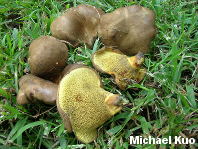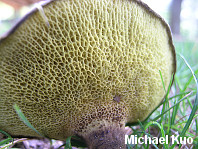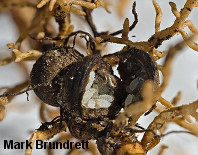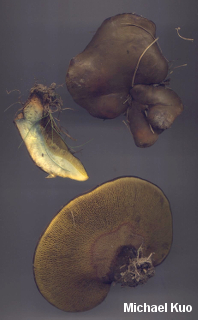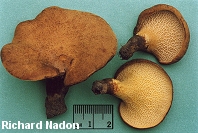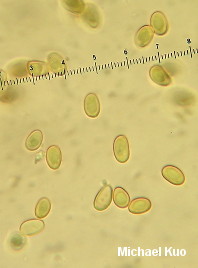| Major Groups > Boletes > Boletinellus merulioides |

|
Boletinellus merulioides [ Basidiomycota > Boletales > Boletinellaceae > Boletinellus . . . ] by Michael Kuo This odd bolete can be found in summer and fall wherever ash trees grow. It features an irregular brown cap, strongly "boletinoid" pores that are angular and widely spaced, and a stem that is almost always off-center, or even lateral. Although it appears only under ash trees, Boletinellus merulioides is not actually mycorrhizal. Rather, it is involved in a symbiosis with Meliarhizophagus fraxinifolii, the "leafcurl ash aphid" (Brundrett & Kendrick, 1987). The mushroom's mycelium forms little knots of tissue ("sclerotia") that surround and protect the aphid (enlarge the amazing photo to the right, kindly provided by Mark Brundrett); in exchange the aphid's honeydew gives nutrients to the fungus. Meanwhile the aphid is busily doing damage to the ash tree. Boletinellus merulioides gets shuffled around between Boletinellus, Gyrodon, Boletinus, and even Boletus. As of this writing the most current data (Nuhn and collaborators, 2013) supports placement in Boletinellus--in a basal position to the Boletinae, suggesting that Boletinellus merulioides is a crocodile-like species in that it has been around since long before the evolution of most of its close relatives. Description: Ecology: Found under green ash trees and other ash trees; probably involved in symbiosis with the leafcurl ash aphid, Meliarhizophagus fraxinifolii (see details above); growing alone, scattered, or gregariously; summer and fall; widely distributed in eastern North America (perhaps also occurring in the southwest). Cap: 5-20 cm, irregular (nearly convex when young, becoming wavy and nearly vase-shaped, or more or less flat); light to dark yellowish brown, or sometimes reddish brown; dry, tacky when wet; bald; soft and leathery; sometimes bruising darker brown. Pore Surface: Pores elongated radially, sometimes appearing almost like gills, with many cross-veins; tubes shallow; running down the stem; yellow to olive, bruising brownish to olive to almost blue (sometimes not bruising); tube layer not easily separable. Stem: 2-4 cm long; 0.5-2.5 cm thick; usually not central (sometimes nearly lateral); yellowish above, colored like the cap (or darker) below; sometimes bruising darker brown or, near the base, blue. Flesh: Whitish to yellowish or yellow; sometimes bruising blue when sliced, especially in the base of the stem and/or just above the tubes. Odor and Taste: Odor fragrant or not distinctive; taste not distinctive. Chemical Reactions: Ammonia purplish red on cap surface; orangish to negative on flesh. KOH dark orange on cap surface; orange on flesh. Iron salts pale orange to negative on cap; bluish gray on flesh. Spore Print: Olive brown. Microscopic Features: Spores 7-10 x 6-7.5 µ; smooth; ellipsoid. Pleurocystidia to about 35 x 10 µ; lageniform. Pileipellis a cutis of mostly erect, cylindric elements 6-9 µ wide. Clamp connections present. REFERENCES: (Schweinitz 1832) Murrill, 1909. (Coker & Beers, 1943; Singer, 1945; Snell & Dick, 1970; Smith & Thiers, 1971; Grund & Harrison, 1976; Smith, Smith & Weber, 1981; Brundrett & Kendrick, 1987; Phillips, 1991/2005; Lincoff, 1992; Metzler & Metzler, 1992; Both, 1993; Horn, Kay & Abel, 1993; Barron, 1999; Bessette, Roody & Bessette, 2000; Roody, 2003; McNeil, 2006; Miller & Miller, 2006; Kuo, 2007; Nuhn et al., 2013.) Herb. Kuo 09029501, 09190701. This site contains no information about the edibility or toxicity of mushrooms. |
© MushroomExpert.Com |
|
Cite this page as: Kuo, M. (2015, May). Boletinellus merulioides. Retrieved from the MushroomExpert.Com Web site: http://www.mushroomexpert.com/boletinellus_merulioides.html |
